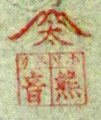Background
The historical Kagekiyo (the Heike general Taira no Kagekiyo) was nicknamed Akushichibyoe, "bad man of the seventh degree," for killing his uncle (after he mistook him for his enemy Minamoto no Yoritomo). Although a formidable warrior, he was later captured after the pivotal naval battle at Dannoura in 1185 when the Genji clan, led by Yoritomo (1147–99), defeated the Heike forces. Exiled to a cave on Hyûga Island, Kagekiyo died of starvation in 1195.
Despite being featured only briefly in the Heike monogatari (Tale of the Heike; a twelfth-century chronicle compiled from oral tradition in the late fourteenth century), Kagekiyo nevertheless assumed a prominent role in legend and in kabuki and puppet dramas called Kagekiyo mono (Kagekiyo plays). One of the best known versions was promoted by Ichikawa Danjuro VII for the codification of the Ichikawa family's Kabuki jûhachiban (Eighteen favorite kabuki plays), an aragoto ("wild business") role with a dotera (padded-dressing-gown), a wig (katsura) with a bushy crown, and makeup called kumadori ("taking the shadows") with red lines (sujiguma or "border stripes") and painted blue beard (hanguma).
Design
 This is a mitate-e (analogue print: 見立); as such, there is no actual recorded performance for Rikan II and Utaemon III in these two roles circa 1833. The two figures appear to be traveling surreptitiously, with Kagekiyo holding an amigasa (woven or braided hat made of rush or straw), which often, in kabuki, indicates that the character is on the move, with the hat serving to hide the face.
This is a mitate-e (analogue print: 見立); as such, there is no actual recorded performance for Rikan II and Utaemon III in these two roles circa 1833. The two figures appear to be traveling surreptitiously, with Kagekiyo holding an amigasa (woven or braided hat made of rush or straw), which often, in kabuki, indicates that the character is on the move, with the hat serving to hide the face.
The sheets are the only ones recorded for this composition, so if there was ever a third sheet (on the far left), it remains unknown.
The publisher's hand-stamped seal on each sheet (incompletely stamped on the right) incorporates the character ta (太) under a mountain peak, and so can be identified as "Fuji-ta." Below that is the seal for the renowned blockcutter Kumazô (hori Kuma, ホリ熊) and the printer Oto (suri Oto, スリ音).
The printing and exceptional state of preservation of this impression — truly a remarkable specimen — demonstrate why the best Osaka prints are celebrated for their quality of design and execution. Sadamasu's composition was carved and printed with the utmost skills, featuring eye-catching patterns in the robes and brilliant use of metallics, all set against an atmospheric night sky. It is only with a wonderful specimen such as this that one can fully appreciate the collaborative achievements of artist, block carver, and printer.
References: KAM, p. 229(365); KAN, no. 17; Museum Fine Arts Boston (inv #11.36004a-b); NKE, p. 253